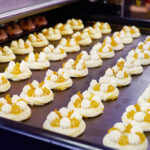By Dr. Richard Parmee, founder and CEO of Sapphire Inspection Systems
The use of low-energy X-ray imaging to detect foreign objects in food products is an established technique on the production line. But the latest generation of X-ray inspection equipment can do so much more than detect unwanted fragments of metal or glass.
With many bakery products now sold as luxury items, often in transparent packaging so that the customer can see what they are buying, the pressure is on to ensure every item leaves the factory in perfect condition. Damaged and non-uniform products are likely to be left on the supermarket shelf, resulting in additional costs and disruption for manufacturers, as well as adding to the issue of food waste.
The detection of foreign objects is based on being able to detect material that is substantially denser – in other words, higher in atomic number – than the food matrix. But guarding against cosmetic issues in luxury food products involves more than just looking for contrasting densities. It also requires looking at levels of contrast – the difference between soft fruit and the background filling, for example – as well as the crevices in the surface of a dessert created by a cutting tool. This requires enhanced detection capabilities and higher resolution.
This kind of inspection calls for the detection of differential greyscales in the inspection image, which are considerably smaller than the variation in the normal range of greyscales in a standard product. For example, a pie which comprises semi-glutinous material, when cut with a narrow blade, will show a channel where the blade has passed through the product. However, after withdrawing the blade, the crevice will tend to close up due to the fluid nature of the pie filling. A similar situation exists with the coverage of raspberries on a pie. The variability in the image is within the normal range for the pie filling.
This variability means the standard approach of adjusting conventional density settings to pick out characteristic features of faulty products is unlikely to succeed, and conventional rule-based algorithms could not be applied because of the irregularity. That’s why the latest generation of X-ray inspection technology uses specially developed tools that allow large image sets to be acquired, with defects in differing positions and orientations. The image sets can be processed automatically, and associated diagnostic data collected and statistically analyzed, to allow a fast and efficient means of analyzing the effectiveness of the algorithms being deployed.
The result is that the technology can help ensure a tart is cut into equal slices, even at the rate of 200 tarts per minute on the production line. It can detect when a multi-bladed cutting tool is offset, resulting in uneven slices, by measuring the center of the slices relative to the outside diameter of the tart. Tarts which fail to meet the quality criterion will be rejected and, if there is a series of rejects, the inspection system will shut down the production line until the tooling is adjusted.
The technology can also help guard against damage to fragile toppings, such as the meringue on lemon meringue pies, by detecting the presence of the small plastic tripod designed to prevent the top being crushed during transportation. And it can check that each tarte au framboise has a consistent covering of raspberries by taking an X-ray image of the product – either within or outside its carton – and applying an image processing algorithm to determine the coverage.
Quality control is crucial for brand reputation, particularly when it comes to luxury items. The latest generation of X-ray inspection technology is now helping manufacturers enjoy the sweet smell of success when it comes to luxury bakery products.
Dr. Richard Parmee is founder and CEO of X-ray inspection technology specialist Sapphire Inspection Systems. As well as designing bespoke solutions, Richard and his team provide a wide range of standard X-ray inspection systems to cater for hundreds of different products in the food, pharmaceutical, and cosmetics industries.














